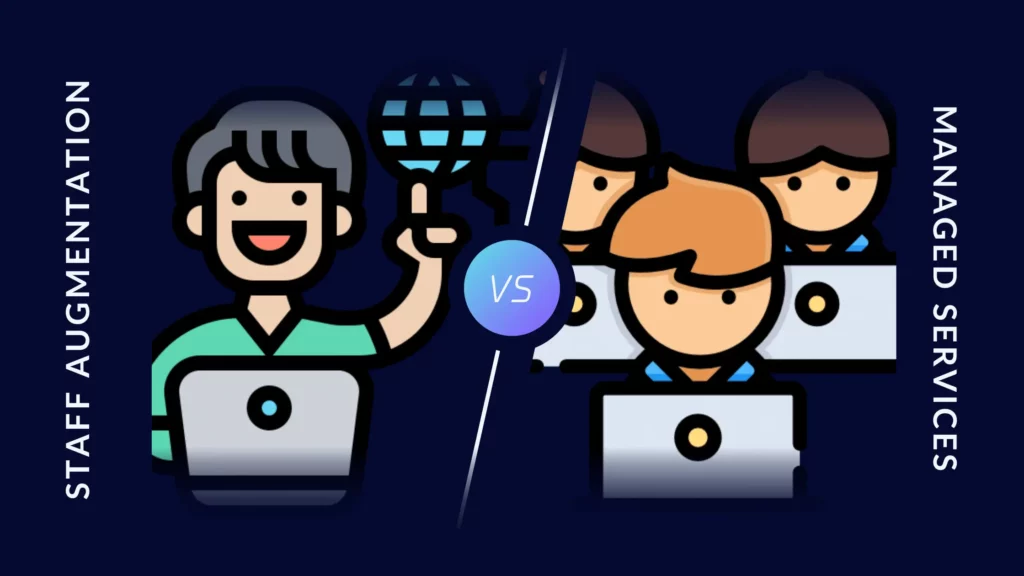IT Staff Augmentation vs Managed Services: Picking the Right Solution for Your Resource Constraints
As an enterprise technology manager or director, you face numerous challenges in today’s rapidly changing tech landscape. Among these challenges is finding the right solution to address resource constraints in your organization. Two popular approaches, IT staff augmentation and managed services, offer distinct advantages and drawbacks. In this article, we will explore IT staff augmentation vs managed services to help you determine the best fit for your enterprise.
We will dive into the key differences between IT staff augmentation and managed services, discussing the benefits, drawbacks, and ideal use cases for each approach. By the end of this article, you will have a better understanding of which solution aligns best with your organization’s needs and goals.

Here’s a quick summary on IT Staff Augmentation vs Managed Services:
| IT Staff Augmentation | Managed Services | |
|---|---|---|
| Pros | ||
| Specialized Expertise | ✔️ Access to specialized skills for short-term projects | ✔️ Comprehensive IT solutions provided by experts |
| Flexibility & Scalability | ✔️ Easily scale workforce up or down based on project needs | Limited flexibility depending on contract terms |
| Control | ✔️ Maintain full control over project direction and staff allocation | Reduced control over IT functions |
| Long-term Solutions | ✔️ Ongoing maintenance, support, and system monitoring | |
| Cons | ||
| Management Overhead | ✔️ Increased management overhead due to coordination and supervision | |
| Continuity & Long-term Needs | Lack of continuity in project knowledge | ✔️ Long-term contracts provide consistency |
| Contract Duration | Short-term contracts may not address ongoing needs | Longer-term contracts may pose challenges with changing needs |
Benefits of IT Staff Augmentation
IT staff augmentation offers several benefits to enterprises facing resource constraints. By bringing in skilled professionals on a short-term basis, organizations can quickly scale their workforce to meet project needs. This approach enables businesses to access specialized expertise, enhance their in-house talent pool, and maintain full control over the project’s direction.
Key Takeaways:
- IT staff augmentation provides quick access to specialized expertise.
- Enterprises can easily scale their workforce up or down based on project requirements.
- Organizations maintain full control over project direction and staff allocation.
Drawbacks of IT Staff Augmentation
Despite its advantages, IT staff augmentation may not always be the best choice for every organization. One of the main drawbacks is the potential for increased management overhead, as your internal team will need to coordinate and supervise the augmented staff. Additionally, staff augmentation may not provide a long-term solution for businesses with ongoing needs, as the contractual nature of augmented staff may lead to a lack of continuity in project knowledge.
Key Takeaways:
- IT staff augmentation can result in increased management overhead.
- It may not be suitable for long-term, ongoing project needs.
- Lack of continuity in project knowledge due to the temporary nature of augmented staff.

Benefits of Managed Services
Managed services offer a comprehensive solution for enterprises looking to outsource their IT needs. This approach enables businesses to focus on their core competencies while the managed services provider (MSP) takes care of IT functions. Managed services often include ongoing maintenance, support, and system monitoring, ensuring that your IT infrastructure remains up-to-date and secure.
Key Takeaways:
- Managed services allow enterprises to focus on core competencies.
- MSPs handle IT functions, including maintenance, support, and system monitoring.
- Managed services ensure up-to-date and secure IT infrastructure.
Drawbacks of Managed Services
While managed services offer numerous benefits, they also come with certain drawbacks that may not suit every organization. One potential issue is the reduced control over IT functions, as your organization will rely on the managed services provider to handle tasks and make decisions. Additionally, managed services may require longer-term contracts, which could lead to challenges if your organization’s needs change rapidly.
Key Takeaways:
- Reduced control over IT functions when relying on managed services.
- Managed services often involve longer-term contracts.
- Potential challenges when organizational needs change rapidly.
Making the Right Choice for Your Organization
When choosing between IT staff augmentation and managed services, it is essential to consider your organization’s unique needs, goals, and constraints. Evaluate the benefits and drawbacks of each approach, and consider factors such as project duration, skill requirements, budget constraints, and the level of control you desire. By carefully weighing these factors, you can make an informed decision that will help your organization overcome resource constraints and achieve its objectives.
Key Takeaways:
- Consider your organization’s unique needs, goals, and constraints when choosing between IT staff augmentation and managed services.
- Evaluate factors such as project duration, skill requirements, budget constraints, and desired control level.
- Make an informed decision to overcome resource constraints and achieve organizational objectives.

Final thoughts on IT staff augmentation vs managed services
Both IT staff augmentation and managed services offer unique benefits and drawbacks when it comes to addressing resource constraints in enterprise technology management. IT staff augmentation provides flexibility and access to specialized skills for short-term projects, while managed services offer comprehensive, long-term solutions for ongoing IT needs. By considering your organization’s specific goals, requirements, and constraints, you can make an informed decision that best suits your needs and helps your organization achieve its objectives.
Keep these things in mind:
- IT staff augmentation offers flexibility and specialized skills for short-term projects.
- Managed services provide comprehensive, long-term solutions for ongoing IT needs.
- Evaluate your organization’s goals, requirements, and constraints when choosing between IT staff augmentation and managed services.
- Consider factors such as project duration, skill requirements, budget constraints, and desired control level.
- Make an informed decision to address resource constraints and achieve your organization’s objectives.
To learn more about IT staff augmentation and managed services, we invite you to explore other articles on our website. If you’d like personalized guidance or have questions about how these solutions can help your organization, please submit an inquiry to reach out to our team of experts. We’re here to help you make the best choice for your enterprise technology needs.